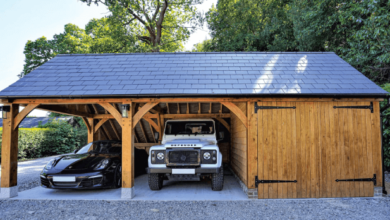Backyard Bliss: Transform Your Garden into a Lush Paradise

Creating a garden that feels like an oasis of tranquility and beauty is a dream many gardening enthusiasts share. Whether you’re working with a modest patch of land or a sprawling backyard, the key to achieving a lush paradise lies in thoughtful planning, clever design, and diligent care.
In this comprehensive guide, we’ll take you through each step of transforming your backyard into a lush paradise.
Planning Your Garden
Assess Your Space
Before you start planting, take a moment to assess your outdoor space. Consider the size, shape, and existing features of your backyard. Take note of areas that receive full sunlight and those that are shaded, as these will influence your plant choices.
Understand Your Climate
Your local climate plays a crucial role in determining what plants will thrive in your garden. Research the hardiness zone of your area and select plants that are well-suited to your specific climate conditions. For example, if you’re in an area with hot summers and cold winters, choose plants that can withstand both extremes.
Choose the Right Plants
Selecting the right plants is essential for creating a sustainable and beautiful garden. Consider incorporating a mix of perennials, annuals, shrubs, and trees to add variety and structure to your space. Native plants are an excellent choice, as they are adapted to your local climate and typically require less maintenance.
Designing for Bliss
Garden Layout Ideas
A well-designed garden layout can significantly enhance the aesthetic and functionality of your space. Start by sketching out a plan that includes pathways, seating areas, and focal points. Curved pathways can add a sense of intrigue and exploration, while straight paths create a more formal look.
Incorporate Seating Areas
Creating comfortable seating areas allows you to enjoy your garden to the fullest. Consider placing benches, swings, or hammocks in strategic locations where you can relax and take in the beauty of your surroundings. If you have a larger space, consider adding a pergola or gazebo for added shade and style.
For larger spaces, a homey sectional couch can provide ample seating while enhancing the overall comfort and style of your garden retreat.
Add Water Features
Water features, such as fountains, ponds, or small waterfalls, can bring a sense of tranquility and movement to your garden. The sound of running water adds to the overall ambiance and can create a soothing atmosphere. Ensure that any water feature you add is appropriately sized for your space and well-maintained to avoid issues like algae buildup.
The Green Thumb Guide
Plant Care Tips
Successful gardening requires consistent care and attention. Here are some practical tips for maintaining a healthy garden:
- Watering Schedules: Establish a regular watering schedule based on the needs of your plants. Early morning is the best time to water, as it allows plants to absorb moisture before the heat of the day.
- Soil Health: Healthy soil is the foundation of a thriving garden. Regularly amend your soil with organic matter, such as compost or aged manure, to improve its structure and fertility.
- Pest Management: Keep an eye out for common garden pests and take action early to prevent infestations. Use natural pest control methods, such as introducing beneficial insects or using organic sprays, to protect your plants without harming the environment.
Sustainability in the Garden
Composting
Composting is an excellent way to recycle organic waste and enrich your soil. Set up a compost bin in a convenient location and regularly add kitchen scraps, yard clippings, and other organic materials. Turn the compost periodically to speed up the decomposition process and produce nutrient-rich compost for your garden.
Water Conservation
Conserving water is essential for maintaining an eco-friendly garden. Consider installing a rain barrel to collect and store rainwater for irrigation. Additionally, using dark brown mulch helps retain soil moisture and reduces the need for frequent watering. If you’re in an area like Salt Lake City, where water conservation is crucial, mulching can be particularly beneficial.
Attracting Beneficial Wildlife
Encouraging beneficial wildlife, such as birds, bees, and butterflies, can enhance the health and beauty of your garden. Plant a variety of flowering plants to provide nectar for pollinators and install bird feeders and houses to attract birds. Avoid using chemical pesticides, as they can harm beneficial insects and disrupt the natural balance of your garden ecosystem.
The Seasonal Garden
Maintaining a lush garden throughout the year requires understanding the seasonal needs of your plants. Here are some tips for each season:
- Spring: Focus on planting new flowers and vegetables, and prepare your soil by adding compost and other amendments.
- Summer: Keep a close eye on watering needs, especially during hot weather. Mulch around plants to help retain moisture and suppress weeds.
- Fall: Clean up fallen leaves and spent plants, and add them to your compost pile. Plant bulbs for spring blooms and consider adding cool-season vegetables.
- Winter: Protect sensitive plants from frost by covering them with frost cloth or bringing potted plants indoors. Use this time to plan for the upcoming growing season.
Conclusion
Transforming your backyard into a lush paradise is a rewarding and fulfilling endeavor. By carefully planning your garden, designing for both beauty and functionality, and adhering to sustainable practices, you can create a space that brings joy and tranquility year-round. Remember, gardening is an ongoing journey, so take your time and enjoy the process of nurturing your outdoor haven.
Ready to start your backyard transformation? Share your gardening tips and experiences in the comments below, and let’s inspire each other to create our very own garden paradises!




